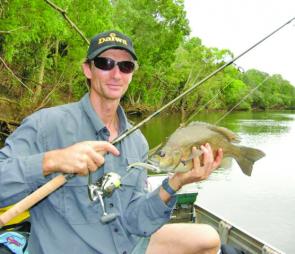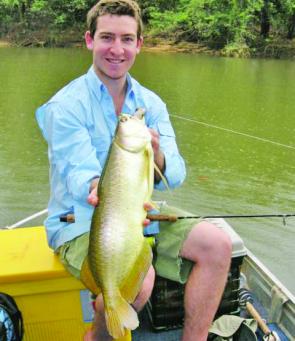I recently enjoyed a week of fishing in one of our pristine cape rivers north of Weipa. The Wenlock is one of the prettiest rivers I have fished with much of its banks lined with the picturesque Nypa Palm.
Once you are in Weipa, the Wenlock can be accessed with an easy one-hour drive over the Mission bridge and a right turn-off to a gravel boat ramp before you reach Mappoon. Be warned the boat ramp is not so easy to negotiate below half tide, as there is a lot of mud to deal with.
We did not make it down to the river mouth near the Mapoon township but spent most of our fishing upstream of the boat ramp. I cannot say that we had an incredible trip by virtue of the barra numbers we caught, unfortunately we had to deal with a severe cold snap that does not reach these parts too often. And there was some unseasonable rain and cool fresh water invading the river that made for difficult fishing conditions.
The Wenlock has many rock bars and boating obstacles so I would advise anyone fishing upstream of the boat ramp to take extreme care, it is not a place where you would like to lose an outboard leg or flip a boat. Do some homework on where these rocks are before roaring off along unknown river stretches.
We knew that the river is often a dirty colour and although we focused our attention on the rock bars at slack water periods, which are usually ideal, they did not fire up as we would have liked. Some of the locals had told us about heavy netting that had occurred a couple of weeks prior to us arriving.
Was that the cause for the lack of fish numbers at prime time? I am not sure, but it was not a good factor to roll into the equation of cooler than normal water temperatures.
We did however enjoy some good fishing and took the opportunity to experiment with some different fishing techniques using soft plastics.
I travelled with my son, David, and a good fishing buddy Peter Atwell in his 100 series Landcruiser. We also met up with another mate who was already up there in Col Upham.
Peter is one of the most forward thinking fishers I know and was full of new equipment and ideas which fitted in well with David’s creativity and newly found zest for using soft plastics. Most of my luring has been with hard bodies so this was a good chance for me to step out of my comfort zone.
Over the week we started off fishing high upstream and worked our way gradually down closer to the boat ramp. By the end of the week we had caught and released countless saratogas and sooties on a variety of small hard bodies and plastics. Many of these fish were real quality, especially some thumping sooty grunter. Amongst these fish were the odd small legal sized barra. Occasionally we found a snag that produced several barra, mostly in the legal size to just under.
We did bring a few home and for the record the biggest barras we caught were about 75cm. They were well short of the ‘one-twenty-somethings’ we are used to catching at this time of the year.
There were a variety of plastics in the boat and the one thing I have always been annoyed by when using these lures is their ability to snag you up.
There are two things to do to avoid a snag-up. Firstly, use lighter weights and, secondly, hide the hook in the lure so it does not stand out. I recommend rigging them with the point of the hook lying flat along the top of the lure.
David developed a Squidgie rig where he got rid of the heavy lead head and used a small ball sinker looped through the leader and eye of the hook in front of the nose. Varying the size of the ball sinker gives a lot more control over presentation and David perfected this method on the Squidgie by slicing off a small section of the plastic dorsal fin, allowing the point of the hook to remain flat and not protrude out.
On one hot session David absolutely brained the barra with this specially rigged green and gold Squidgie. He was outfishing the rest of us three to one.
Peter had a lot of success with his array of plastics which also had the hook point concealed and he introduced us to snapbacks.
The snapback plastics were excellent and are certainly worth getting hold of. They are incredibly lifelike and durable and would outlast Squidgies indefinitely. We found the Squidgies could be destroyed after one good fish but the snapbacks had a much longer life.
Peter also had a variety of rigs but the key was to go lighter. And by using split shot on the rigs he was able to adapt and change weights to suit the conditions and have more control. Presentation technique was pretty simple; work out the depth you are fishing in and the likely fish holding point. Cast to your target, let the lure sink close to the desired depth and then two to three short whips with the rod and let it sink before slowly retrieving. Often the lure would get taken on the drop and within the first few feet of an accurately placed cast. With practice it is possible to keep the lure near the structure or target for long periods – which increases your hook up chances.
The easiest way to learn technique is to purchase any of the wide range of plastics DVD’s, which can clearly illustrate in film how productive these lures can be. Practising in the back yard swimming pool is a good way to gain an understanding of how the plastic behaves in response to your rod movements.
The hook-up when using soft plastics is certainly different and it takes a bit of discipline to refrain from striking once you feel your lure slurped down. Once you sense your line moving through the water after the fish has inhaled, it is merely a matter of taking up any slack before coming up solid.
We mostly found the single hook would pin the fish through the corner of the mouth. Occasionally if you didn’t realise the take on the drop, the lure would really be hooked down deep. Overall this is fun way to fish and adds a whole new dimension to your lure presentation. It is certainly going to be a major part of my lure casting methods, especially having experienced how productive they can be.
The cooler weather is still hanging around and most local fishers are looking forward to some warmer weather. The main attraction in the rivers has been plenty of big queenies moving in and providing some excellent action on all the usual techniques.
Offshore, when the weather has allowed, there are heaps of Spaniards on the top water and some nice large mouth nannies in the deep water between the reefs.
Bottom bouncing on the reefs has produced some decent coral trout around the 25cm mark. This should be a similar scenario throughout the month of September that is usually a top fishing month. Till next month, good fishing!
Reads: 4106
The Wenlock River produced quality sooty grunter.

This saratoga was caught upstream on a modified Squidgie.




